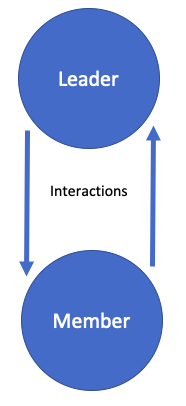
In this article, we’re going to look at the Leader-Member Exchange Theory (or LMX for short). We will assess how it helps us understand interactions and relationships within a business and how they can impact performance.
Background to Leader Member Exchange Theory
The Leader-Member Exchange Theory looks to examine the relationships between leaders/managers and their team/subordinates, theorizing how these relationships (good or bad) can drive effectiveness within an organization.
The lessons we learn from this model can drive changes in our attitudes and behavior and offer ways where we can excel either as a manager or a subordinate.
What are you like as a leader?
If you manage people, the chances are you will have a mix of subordinates from different ages, backgrounds, skills, appetite and capabilities. If you’re a leader, do you treat everyone the same? Do you:
- Give everyone equal access to your time?
- Give everyone the same sort of jobs and activities (with equal opportunities for them to excel).
- Communicate with them in the same way.
- Have the same levels of trust.
The answer is probably not.
The chances are you find some of your team invaluable. They are the ones you’ll talk to often, who’ll go the extra mile that deliver what you need and that you trust with the more critical tasks. These are your A-team.
With the rest of your team, you may not communicate as much; you might have concerns about capability and will probably just delegate the more routine day to day tasks to them.
Whether you’re a leader or a subordinate, you’ve probably witnessed this in your organization where some are ‘closer’ to their Manager than others. This can lead to those having more influence, access to career advancement etc.
But why is this, and does the relationship drive performance and opportunity?
Let’s take a look at how the Leader-Member Exchange theory views it.
What is the Leader-Member Exchange Theory?
The Leader-Member Exchange theory ( or LMX for short) first came to prominence during the 1970s from researchers, including James Dulebohn.
Leadership Member Exchange Theory has several facets:
- Leadership is viewed as a process.
- There is a Key focus on interactions between leaders and subordinates.
- Interactions are seen as vertical i.e. leader to subordinate or subordinate to leader.
- Communication is seen as dyadic (two way)
Here is a diagram that illustrates how these interactions work.

The theories central message is:
- Leaders do not treat all team members the same way.
- The quality of interactions can differ from low quality to high quality.
- The quality of interactions can drive the performance of both the individual and the leader
- High-quality interactions can boost opportunities, including career advancement, access to training, and work experience plus access to more complex and rewarding tasks.
- Low-quality interactions can have an adverse impact on both a team and the organization.
The theory proposes that there are two groups of subordinates with characteristically different interactions and relationships with their leader.
These groups are:
- In group – characterized by good relationships that drive benefits in both directions.
- High-Quality interactions,
- Greater flow of information
- Built on reciprocated liking, trust, and confidence.
- Out group, characterized by:
- Neutral (or negative) relationship
- Formal communications based around the job role and description.
- Routine work, characterised by a lack of access to complex and critical (often reward laden) tasks.
A direct impact is that members of the “out” group have few opportunities for change (such as access to more complex tasks to “impress” their leader). The ones outside can find themselves left “just to get on with it” and find that their careers “wither on the vine”. There is likely to be higher staff turnover within the out-group.
It’s worth noting that even though a member of staff might be in the out-group that does not mean that they don’t contribute to an organization’s success. Out group members can still be effective in driving an organization forward.
In many organizations, without effort by the Manager, this can become self-fulfilling with the Manager building up relationships with certain staff. The staff with good relationships are likely to be more effective than the staff that doesn’t.
You can see in the diagram below how the In-group and the Out-group works.

Stages of Leader-Member Exchange Theory
The theory suggests that leader/subordinate relationships go through several stages:
1. Role-Taking
On initially joining a team, the staff member’s talents are assessed by the leader; the subordinate defines communication and work strategies to satisfy their leader in line with expectations around performance, work ethic, and loyalty.
2. Role-Making
As the longevity of the role increases, leaders will build relationships with the individuals (being either close or demonstrate a level of distance) culminating in the team member being categorised within one of the two groups:
- In-group
- Out-group
Note that classification into these groups is not explicit; it is often carried out subconsciously often driven by factors as simple as how the leader relates to that member of staff (i.e reasons relating to social or demographic).
3. Routinization
Interactions between staff and leaders become reinforced and fit into regular patterns.
In-Group team members continue to develop trust with their leader through attributes like their work ethic, reliability, and respect. Tasks are delegated out, prioritizing the in-group with more complex and rewarding activities. Out-Group members may demonstrate further distance from their leader (even to the extent of disliking them).
Once a presence in a particular group has been established, it can become extremely challenging to change. This environment can eventually lead to disruption. Team members who are part of the out-group often look to change their circumstances. Those that do are faced with simple options, change departments or leave the organization all together with the resultant staff turnover having a significant impact on an organization.
Using the Leader-Member Exchange Theory
Armed with this knowledge and recognizing that better performance can be obtained from the in-group, you can look to utilize the theory yourself as a leader by following several steps:
1/ Identify your out-group
- Who are they
- Why are they in the out-group? i.e
- Bad behavior
- Poor performance
2/ Make efforts on building and improving relationships with the whole team
- Hold regular reviews with them
- Engage with Individuals on a personal level.
- Allocate tasks fairly across the team.
- Facilitate two-way dialogue
- Are they happy with their job?
- How can their job be improved
- How can you develop their skills?
- What challenges can you provide them?
- Is the manager’s expectations being set?
- Which aspects require improving from the leader’s perspective.
Strengths of the Leader-Member Exchange theory
The theory represents an interesting insight into the role of communication and bonding in effective management. It offers many key strengths, including:
- Confirms the perception of how people within organizations work with their leader
- Supports the fact that managers/leaders are likely to have privileged members within their teams.
- Uses the theory of two-way interactions
- Shows the importance of positive interactions
- A positive outcome for the business if the focus is on in-group
Weaknesses of the Leader-Member Exchange theory
The theory also has a number of weaknesses:
- Qualitative data around the interactions from managers to subordinates is questionable
- It avoids the social and demographic impact of relationships
- It assumes all employees are equal
- What about staff with previous issues or risks?
- Does not take into account the longevity of employment
- People naturally perform differently.
- There is a need to hit objectives so managers are likely to place best performing candidates to achieve success.
A key weakness is the impact of other attributes that may drive a relationship, age, social circumstances, background, interests etc all have a part to play in relationship building. It is difficult to merely consider the influences of the work environment.
Summary
The Leader-Member Exchange Theory makes some fine contributions around the effect of leadership/subordinate interactions and performance.
Aspects of the theory are easily recognizable, and you’ve probably experienced some of them yourself.
The Leader-Member Exchange Theory can offer a substantial opportunity for businesses to review opportunities for improvement. Driving best practice in manager/staff relations and reducing the impact of negative relationships on business performance.
We hope that you loved the article, as ever if you have comments, we’d love to hear them! Please use the comments section below or fire us a message on Twitter.
This post is part of our Management & Leadership Guide.